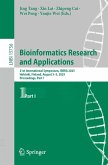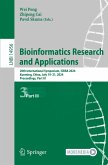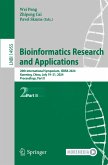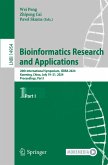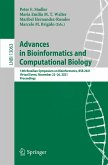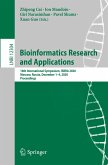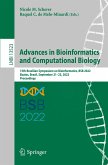Bioinformatics Research and Applications
21st International Symposium, ISBRA 2025, Helsinki, Finland, August 3-5, 2025, Proceedings, Part II
Herausgegeben:Tang, Jing; Lai, Xin; Cai, Zhipeng; Peng, Wei; Wei, Yanjie
Bioinformatics Research and Applications
21st International Symposium, ISBRA 2025, Helsinki, Finland, August 3-5, 2025, Proceedings, Part II
Herausgegeben:Tang, Jing; Lai, Xin; Cai, Zhipeng; Peng, Wei; Wei, Yanjie
- Broschiertes Buch
- Merkliste
- Auf die Merkliste
- Bewerten Bewerten
- Teilen
- Produkt teilen
- Produkterinnerung
- Produkterinnerung
This two-set volume LNCS 15756 and 15767 constitutes the refereed proceedings of the 21st International Symposium on Bioinformatics Research and Applications, ISBRA 2025, held in Helsinki, Finland, during August 3 5, 2025.
The 66 full papers were carefully reviewed and selected from 167 submissions. This year s symposium brought together leading researchers, scientists, and industry professionals from around the world to share cutting-edge advancements, foster collaboration, and explore the future of bioinformatics and computational biology.
Andere Kunden interessierten sich auch für
![Bioinformatics Research and Applications Bioinformatics Research and Applications]() Bioinformatics Research and Applications62,99 €
Bioinformatics Research and Applications62,99 €![Bioinformatics Research and Applications Bioinformatics Research and Applications]() Bioinformatics Research and Applications42,99 €
Bioinformatics Research and Applications42,99 €![Bioinformatics Research and Applications Bioinformatics Research and Applications]() Bioinformatics Research and Applications68,99 €
Bioinformatics Research and Applications68,99 €![Bioinformatics Research and Applications Bioinformatics Research and Applications]() Bioinformatics Research and Applications68,99 €
Bioinformatics Research and Applications68,99 €![Advances in Bioinformatics and Computational Biology Advances in Bioinformatics and Computational Biology]() Advances in Bioinformatics and Computational Biology42,99 €
Advances in Bioinformatics and Computational Biology42,99 €![Bioinformatics Research and Applications Bioinformatics Research and Applications]() Bioinformatics Research and Applications38,99 €
Bioinformatics Research and Applications38,99 €![Advances in Bioinformatics and Computational Biology Advances in Bioinformatics and Computational Biology]() Advances in Bioinformatics and Computational Biology42,99 €
Advances in Bioinformatics and Computational Biology42,99 €-
-
-
This two-set volume LNCS 15756 and 15767 constitutes the refereed proceedings of the 21st International Symposium on Bioinformatics Research and Applications, ISBRA 2025, held in Helsinki, Finland, during August 3 5, 2025.
The 66 full papers were carefully reviewed and selected from 167 submissions. This year s symposium brought together leading researchers, scientists, and industry professionals from around the world to share cutting-edge advancements, foster collaboration, and explore the future of bioinformatics and computational biology.
The 66 full papers were carefully reviewed and selected from 167 submissions. This year s symposium brought together leading researchers, scientists, and industry professionals from around the world to share cutting-edge advancements, foster collaboration, and explore the future of bioinformatics and computational biology.
Produktdetails
- Produktdetails
- Lecture Notes in Computer Science 15757
- Verlag: Springer / Springer Nature Singapore / Springer, Berlin
- Artikelnr. des Verlages: 89549584, 978-981-95-0694-1
- Seitenzahl: 452
- Erscheinungstermin: 1. August 2025
- Englisch
- Abmessung: 235mm x 155mm x 25mm
- Gewicht: 680g
- ISBN-13: 9789819506941
- ISBN-10: 9819506948
- Artikelnr.: 74741349
- Herstellerkennzeichnung
- Springer-Verlag KG
- Sachsenplatz 4-6
- 1201 Wien, AT
- ProductSafety@springernature.com
- Lecture Notes in Computer Science 15757
- Verlag: Springer / Springer Nature Singapore / Springer, Berlin
- Artikelnr. des Verlages: 89549584, 978-981-95-0694-1
- Seitenzahl: 452
- Erscheinungstermin: 1. August 2025
- Englisch
- Abmessung: 235mm x 155mm x 25mm
- Gewicht: 680g
- ISBN-13: 9789819506941
- ISBN-10: 9819506948
- Artikelnr.: 74741349
- Herstellerkennzeichnung
- Springer-Verlag KG
- Sachsenplatz 4-6
- 1201 Wien, AT
- ProductSafety@springernature.com
Prediction of High-Altitude Pulmonary Edema Based on Resampling and Ensemble Learning.- LGFMDA: miRNA-disease association prediction with local and global feature representation learning.- TSCF-Net: A Temporal-Spectral Cross-Fusion Network for Low-channel EEG Motor Imagery Classification.- HCM-Net: Hybrid CNN and Mamba Network with Multi-scale Awareness Feature Fusion for Lung Cancer Pathological Complete Response Prediction.- PrePSL: A Pre-training Method for Protein Subcellular Localization Using Graph Auto-Encoder and Protein Language Model.- MOGATFF: An Explainable Multi-Omics Prediction Model with Feature Enhancement for Genotype-Phenotype Association Analysis.- Accurate and Interpretable Wound Healing Progress Detection Based on a Task-related Knowledge Refinement Learning Method.- A novel weighted network control model for identifying coding and non-coding drivers in cancer.- A Survival Prediction Model Integrating Hierarchical Pathological Image and Pathway Features.- Identification of piRNA-disease association based on contrastive learning.- Autonomous Generation of an Autism Knowledge Question-and-Answer Dataset Using Large Language Models.- Double Metaphone Blocking: An Innovative Blocking Approach to Record Linkage.- Integrating High-Throughput RNA-RNA Interaction Data into RNA Secondary Structure Prediction.- GDCA-TransUNet for Dual-Stage Attention Enhanced Multi-Organ Segmentation in Abdominal CT Images.- E(3)-invariant diffusion model for pocket-aware peptide generation.- Simulating viral evolution and immune escape reinfection dynamics using agent-based modelling.- Practical colinear chaining on sequences revisited.- EnzHier: High-Precision Enzyme Function Prediction through Multi-Scale Feature Integration and Hierarchical Contrastive Learning.- Bidirectional Position-Context Feature Representation for Predicting DNA/RNA Modification Sites.- Optical Flow-Augmented Dual-Stream Network for Left Ventricular Ejection Fraction Prediction.- Joint Sparse Precision Matrix Estimation for Cancer Diagnosis.- An Efficient Parallel List Ranking Algorithm for Graph Concatenation on BSP Graph System.- scCMA:a contrastive masked autoencoder for single-cell RNA-seq embedding.- Drug-Target Interaction Prediction via Substructure Similarity-Guided Denoising and Hierarchical Feature Fusion.- Bioinformatics Course Reform Through Projects integrating History, Theory, and Practice.- BiGDC-BrainAgeNet: Enhancing EEG-Based Brain Age Prediction with Bidirectional Graph Diffusion Convolutions.- CT-Semi-Net: Segmentation of infected areas in lung CT images based on attention mechanism and semi-supervised learning.- Dynamic Knowledge-aware LLM for Adverse Drug Reaction Entity Recognition.- LiteSCTransNet: Lightweight CNN-Transformer for 3D Medical Image Segmentation.- ACMSI: An Innovative Automated Analysis Application Utilizing Computer Vision for Accurate Microsatellite Instability Classification.- AlloPED: Leveraging Protein Language Models and Structure Features for Allosteric Site Prediction.- Parameterized Algorithms for the Tree Containment Problem on Multifurcating Phylogenetic Network.
Prediction of High-Altitude Pulmonary Edema Based on Resampling and Ensemble Learning.- LGFMDA: miRNA-disease association prediction with local and global feature representation learning.- TSCF-Net: A Temporal-Spectral Cross-Fusion Network for Low-channel EEG Motor Imagery Classification.- HCM-Net: Hybrid CNN and Mamba Network with Multi-scale Awareness Feature Fusion for Lung Cancer Pathological Complete Response Prediction.- PrePSL: A Pre-training Method for Protein Subcellular Localization Using Graph Auto-Encoder and Protein Language Model.- MOGATFF: An Explainable Multi-Omics Prediction Model with Feature Enhancement for Genotype-Phenotype Association Analysis.- Accurate and Interpretable Wound Healing Progress Detection Based on a Task-related Knowledge Refinement Learning Method.- A novel weighted network control model for identifying coding and non-coding drivers in cancer.- A Survival Prediction Model Integrating Hierarchical Pathological Image and Pathway Features.- Identification of piRNA-disease association based on contrastive learning.- Autonomous Generation of an Autism Knowledge Question-and-Answer Dataset Using Large Language Models.- Double Metaphone Blocking: An Innovative Blocking Approach to Record Linkage.- Integrating High-Throughput RNA-RNA Interaction Data into RNA Secondary Structure Prediction.- GDCA-TransUNet for Dual-Stage Attention Enhanced Multi-Organ Segmentation in Abdominal CT Images.- E(3)-invariant diffusion model for pocket-aware peptide generation.- Simulating viral evolution and immune escape reinfection dynamics using agent-based modelling.- Practical colinear chaining on sequences revisited.- EnzHier: High-Precision Enzyme Function Prediction through Multi-Scale Feature Integration and Hierarchical Contrastive Learning.- Bidirectional Position-Context Feature Representation for Predicting DNA/RNA Modification Sites.- Optical Flow-Augmented Dual-Stream Network for Left Ventricular Ejection Fraction Prediction.- Joint Sparse Precision Matrix Estimation for Cancer Diagnosis.- An Efficient Parallel List Ranking Algorithm for Graph Concatenation on BSP Graph System.- scCMA:a contrastive masked autoencoder for single-cell RNA-seq embedding.- Drug-Target Interaction Prediction via Substructure Similarity-Guided Denoising and Hierarchical Feature Fusion.- Bioinformatics Course Reform Through Projects integrating History, Theory, and Practice.- BiGDC-BrainAgeNet: Enhancing EEG-Based Brain Age Prediction with Bidirectional Graph Diffusion Convolutions.- CT-Semi-Net: Segmentation of infected areas in lung CT images based on attention mechanism and semi-supervised learning.- Dynamic Knowledge-aware LLM for Adverse Drug Reaction Entity Recognition.- LiteSCTransNet: Lightweight CNN-Transformer for 3D Medical Image Segmentation.- ACMSI: An Innovative Automated Analysis Application Utilizing Computer Vision for Accurate Microsatellite Instability Classification.- AlloPED: Leveraging Protein Language Models and Structure Features for Allosteric Site Prediction.- Parameterized Algorithms for the Tree Containment Problem on Multifurcating Phylogenetic Network.


